Report of Tuckerella pavoniformis (Acari: Tuckerellidae) on Mamey, Mammea americana (Calophyllaceae), in Northwestern Peru
Abstract
:Simple Summary
Abstract
1. Introduction
2. Materials and Methods
2.1. Studied Area
2.2. Peacock Mite Sampling and Identification
2.3. The Biometric Characteristics of the Fruits Infested by Peacock Mites
- − weight of fruit (Wfruit), seeds (Wseed) and epicarp (Wepicarp) (digital scale, precision 0.10 g),
- − length of fruit measured using a slide caliper (precision 0.01 mm),
- − circumference of fruit determined with a meter ribbon (precision 1 mm).
- − weight of pulp (Wpulp) established using the equation,
- − percentage of pulp (P%) using the equation:
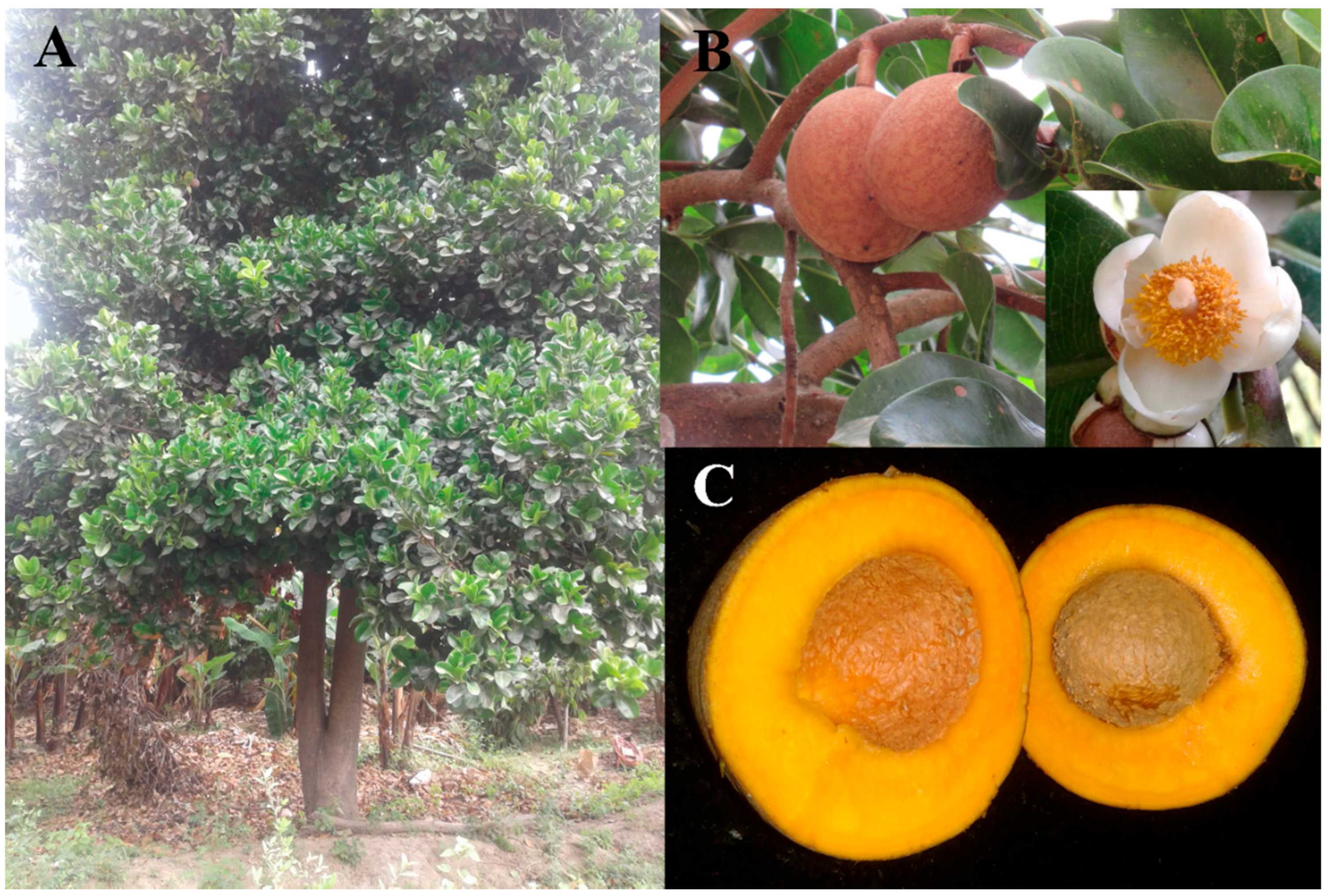
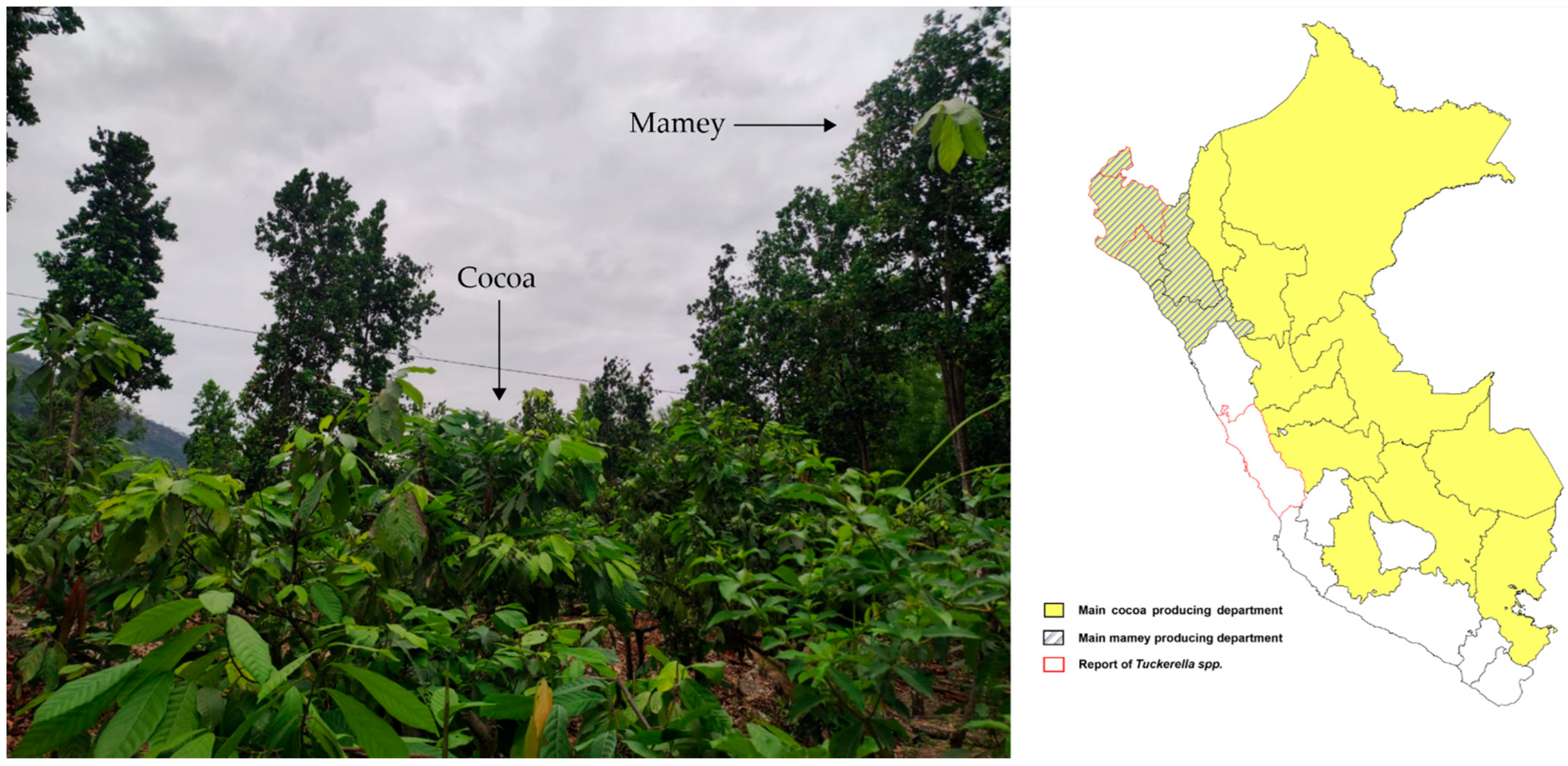
3. Results and Discussion
Author Contributions
Funding
Institutional Review Board Statement
Data Availability Statement
Acknowledgments
Conflicts of Interest
References
- Ewing, H.E. Three new species of peculiar and injurious spider mites. Proc. Entomol. Soc. Wash. 1922, 24, 104–108. [Google Scholar]
- Tucker, R.W.E. Some south African mites. Mainly Tetranychidae and Eriophyidae. Union S. Afr. Dept. Agric. Div. Ent. Mem. 1926, 5, 1–15. [Google Scholar]
- Womersley, H. Studies in Australian Acarina Tetranychidae and Trichadenidae. Trans. R. Soc. S. Aust. 1940, 64, 233–265. [Google Scholar]
- Baker, E.W.; Pritchard, A.E. The family categories of Tetranychoid mites, with a review of the new families Linotetranidae and Tuckerellidae. Ann. Entomol. Soc. Am. 1953, 46, 243–258. [Google Scholar] [CrossRef]
- Miller, L.W. A new species of Tuckerella (Acarina: Tetranychoidea, Tuckerellidae) from Tasmania. In The Papers and Proceedings of the Royal Society of Tasmania; Royal Society of Tasmania: Hobart, Australia, 1964; Volume 98, pp. 79–84. [Google Scholar]
- Ochoa, R.; Aguilar, H.; Vargas, C. Phytophagous Mites of Central America: An Illustrated Guide; CATIE: Cartago, Costa Rica, 1994; pp. 1–234. [Google Scholar]
- Lim, T.K. Mammea Americana. In Edible Medicinal and Non-Medicinal Plants; Springer: London, UK, 2012; pp. 134–142. [Google Scholar]
- Morton, J.F. Fruits of Warm Climates; Dowling, C.F., Ed.; ECHO Inc.: Miami, FL, USA, 1987; pp. 304–307. [Google Scholar]
- Duarte, O.; Paull, R. Exotic Fruits and Nuts of the New World; CABI: Wallingford, UK, 2015; 332p. [Google Scholar]
- CABI. Invasive Species Compendium. 2019. Available online: https://www.cabi.org/isc/datasheet/32390 (accessed on 8 November 2021).
- Zamore, R.; Ebroin, A. Vertus et Secrets Desplantes Médicinales des Antilles; Kolodziej, E., Ed.; Fort-de-France, Martinique, France. 1984, p. 13. Available online: https://kolibris.univ-antilles.fr/discovery/fulldisplay?vid=33UAG_INST:33UAG_INST&tab=TOUT&docid=alma991000410419705746&lang=fr&context=L&adaptor=Local%20Search%20Engine&query=sub,exact,%20speciation%20,AND&mode=advanced&offset=30 (accessed on 17 March 2022).
- Poupon, J.; Chauvin, G. Les arbres de la Martinique. Off. Natl. For. Guadeloupe 1983, 210–211. [Google Scholar]
- Mosquera, W.G.; Criado, L.Y.; Guerra, B.E. Actividad antimicrobiana de hongos endófitos de las plantas medicinales Mammea americana (Calophyllaceae) y Moringa oleifera (Moringaceae). Biomédica 2020, 40, 55–71. [Google Scholar] [CrossRef] [Green Version]
- Acosta, I.; Sandoval, P.; Bautista, D.; Hernández, N.; Cárdenas, J.F.; Martínez, V.M. Bioadsorción de cromo (VI) por la cáscara de mamey (Mammea americana L.). Av. Cienc. Ing. 2012, 3, 1–9. [Google Scholar]
- Little, E.L.; Wadsworth, F.H. Common trees of Puerto Rico and the Virgin Islands. In Agriculture Handbook, No. 249; U.S. Department of Agriculture: Washington, DC, USA, 1964; 548p. [Google Scholar]
- Mahecha, V.G.E.; Echeverri, R.R. Arboles del Valle del Cauca; Litografia Arco: Bogotá, Colombia, 1983; 208p. [Google Scholar]
- Dunthorn, M. Cryptic dioecy in Mammea (Clusiaceae), Plant Syst. Evol. 2004, 249, 191–196. [Google Scholar]
- Francis, J.K. Mammea americana L. Mamey, Mammee-Apple; Note SO-ITF-SM-22; Department of Agriculture, Forest Service, Southern Forest Experiment Station: New Orleans, LA, USA, 1989; 4p. [Google Scholar]
- Mourão, K.S.M.; Beltrati, C.M. Morfología y anatomía de frutos y semillas en desarrollo de Mammea americana L. (Clusiaceae). Rev. Braz. J. Biol. 2000, 60, 70–111. [Google Scholar] [CrossRef] [Green Version]
- Gervais, L.; Lavigne, C. Mamey (Mammea americana L.) in Martinique Island: An inheritance to be developed. Fruits 2007, 62, 237–246. [Google Scholar] [CrossRef] [Green Version]
- Liogier, A.H. Arboles Dominicanos; Academia de Ciencias de la República Dominicana: Santo Domingo, Dominican Republic, 1978; 220p. [Google Scholar]
- Agrodataperu. Exportaciones Agropecuarias del Perú. 2020. Available online: https://www.agrodataperu.com/2021/01/frutas-pulpas-aguacate-palta-arandanos-peru-exportacion-2020-diciembre.html (accessed on 8 November 2021).
- Krantz, G.W.; Walter, D.E. (Eds.) Collecting, rearing, and preparing specimens. In A Manual of Acarology, 3rd ed.; Texas Tech University Press: Lubbock, TX, USA, 2009; pp. 83–94. [Google Scholar]
- Meyer, M.K.P.S.; Ueckermann, E.A. A review of some species of the families Allochaetophoridae, Linotetranidae and Tuckerellidae (Acari: Tetranychoidea). Int. J. Acarol. 1997, 23, 67–92. [Google Scholar] [CrossRef]
- Escobar-Garcia, H.A.; de Andrade, D.J.; Beard, J.J.; Ochoa, R. Peacock mites on cocoa in Peru (Acari: Tuckerellidae: Tuckerella): Their economic importance and a key to species. Syst. Appl. Acarol. 2021, 26, 519–528. [Google Scholar] [CrossRef]
- Mineiro, J.L.C.; Raga, A.; Lofego, A.C. Ocorrência de ácaros (Arachnida: Acari) em aceroleira (Malpighia emarginata A.DC.) no Estado de São Paulo. Arq. Inst. Biol. 2004, 71, 282–285. [Google Scholar]
- Mineiro, J.L.C.; Lofego, A.C.; Raga, A.; de Moraes, G.J. Primeiros registros dos ácaros Amblyseiella setosa Muma (Phytoseiidae) e Tuckerella pavonformis (Ewing) (Tuckerellidae) no Brasil. Arq. Inst. Biol. 2005, 72, 395–396. [Google Scholar] [CrossRef]
- Flechtmann, C.H.W.; Kreiter, S.; Etienne, J.; Moraes, G. Plant mites (Acari) of the French Antilles. 1. Tetranychoidea (Prostigmata). Acarologia 1999, 40, 136–144. [Google Scholar]
- Aguilar, H.; Murillo, P. New hosts and records of plant feeding mites for Costa Rica: Interval 2002–2008. Agron. Costarric. 2008, 32, 7–28. Available online: https://www.cabi.org/ISC/abstract/20093044931 (accessed on 18 February 2022).
- Ochoa, R. The genus Tuckerella in Costa Rica (Acari: Tuckerellidae). Int. J. Acarol. 1989, 15, 205–207. Available online: http://dx.doi.org/10.1080/01647958908683850 (accessed on 18 February 2022). [CrossRef]
- Cao, L.J.; Leal, H.J.L. Ácaros Tuckerélidos (Acari, Tetranychoidea, Tuckerellidae) asociados a Casuarina equisetifolia L. en la Habana. Fitosanidad 2011, 15, 69–72. [Google Scholar]
- Suárez, A. Catálogo de ácaros de la provincia de Guantánamo, La Habana. Fitosanidad 2004, 8, 23–31. [Google Scholar]
- Huanca, J.; Vergara, C. Primer Registro del Acaro Fitófago del Genero Tuckerella Womersley (Prostigmata: Tuckerellidae) en Perú; Resúmenes, Sociedad Entolomológica de Perú; LII Convención Nacional de Entomología: Iquitos, Perú, 2010; p. 47. [Google Scholar]
- Turner, J.C.L. Biology and Management of Allokermes kingii (Hemiptera: Kermesidae) on Oak Trees. Master’s Thesis, University of Florida, Gainesville, FL, USA, 2004; 55p. [Google Scholar]
- Akamine, E.K.; Goo, T. Respiration and ethylene production in mammee apple (Mammea americana L.). J. Amer. Soc. Hortic. Sci. 1978, 103, 308–310. [Google Scholar]
- Yahia, E.M. Sapodilla and related fruits. In Handbook No. 66; U.S. Department of Agriculture: Washington, DC, USA, 2004. [Google Scholar]
- Yahia, E.M.; Guttierrez-Orozco, F. Mamey Apple (Mammea americana L.). In Postharvest Biology and Technology of Tropical and Subtropical Fruits; Yahia, E.M., Ed.; Woodhead Publishing Series in Food Science, Technology and Nutrition; Woodhead Publishing: Cambridge, UK, 2011; pp. 474–481. [Google Scholar] [CrossRef]
- Migeon, A.; Dorkeld, F. Spider Mites Web: A Comprehensive Database for the Tetranychidae. 2006–2021. Available online: http://www1.montpellier.inra.fr/CBGP/spmweb (accessed on 8 November 2021).
- Demite, P.R.; Moraes, G.J.; McMurtry, J.A.; Denmark, H.A.; Castilho, R.C. Phytoseiidae Database. 2021. Available online: www.lea.esalq.usp.br/phytoseiidae (accessed on 8 November 2021).
- De Leon, D. Some Mites of the Caribbean Area; Allen Press, Inc.: Lawrence, KC, USA, 1967; pp. 1–46. [Google Scholar]
- Cao, J. La familia Tuckerellidae y su presencia en Cuba. Cienc. y Técnica en la Agric. Cítricos y otros Frut. 1980, 3, 47–56. [Google Scholar]
- Kim, J.; Kim, S.; Ju, C.; Son, H.I. Unmanned aerial vehicles in agriculture: A review of perspective of platform, control, and applications. IEEE Access 2019, 7, 105100–105115. [Google Scholar] [CrossRef]
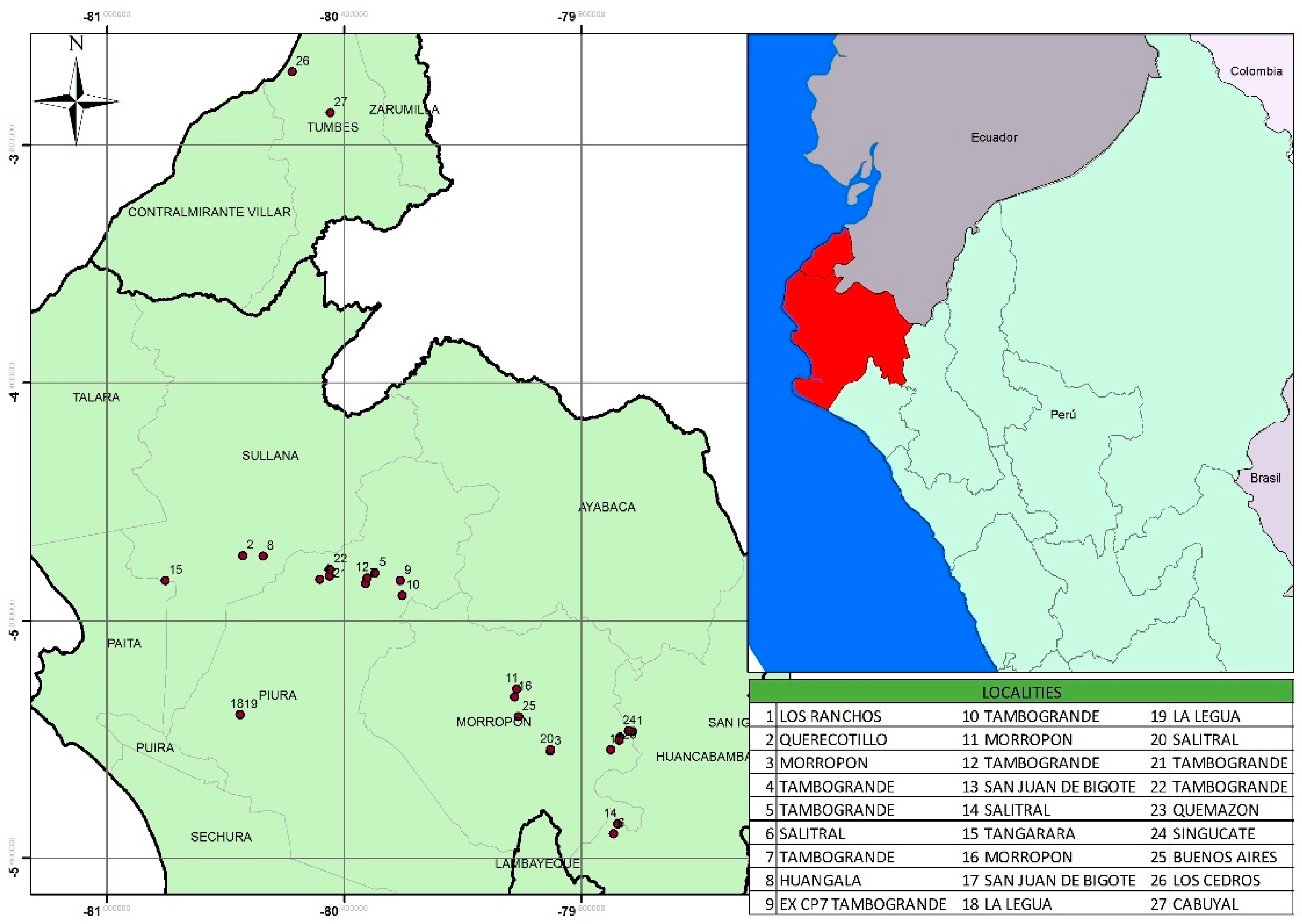
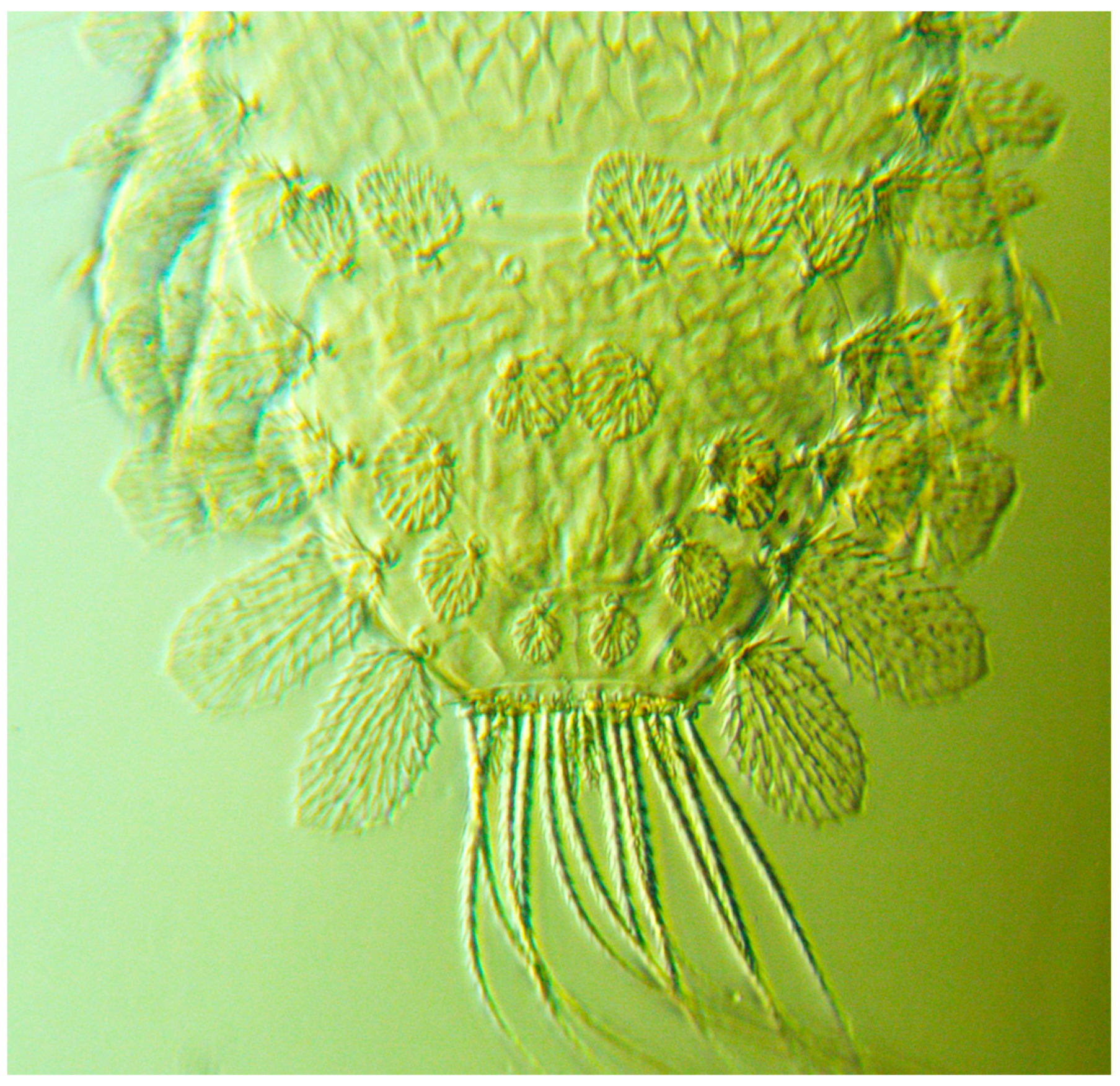
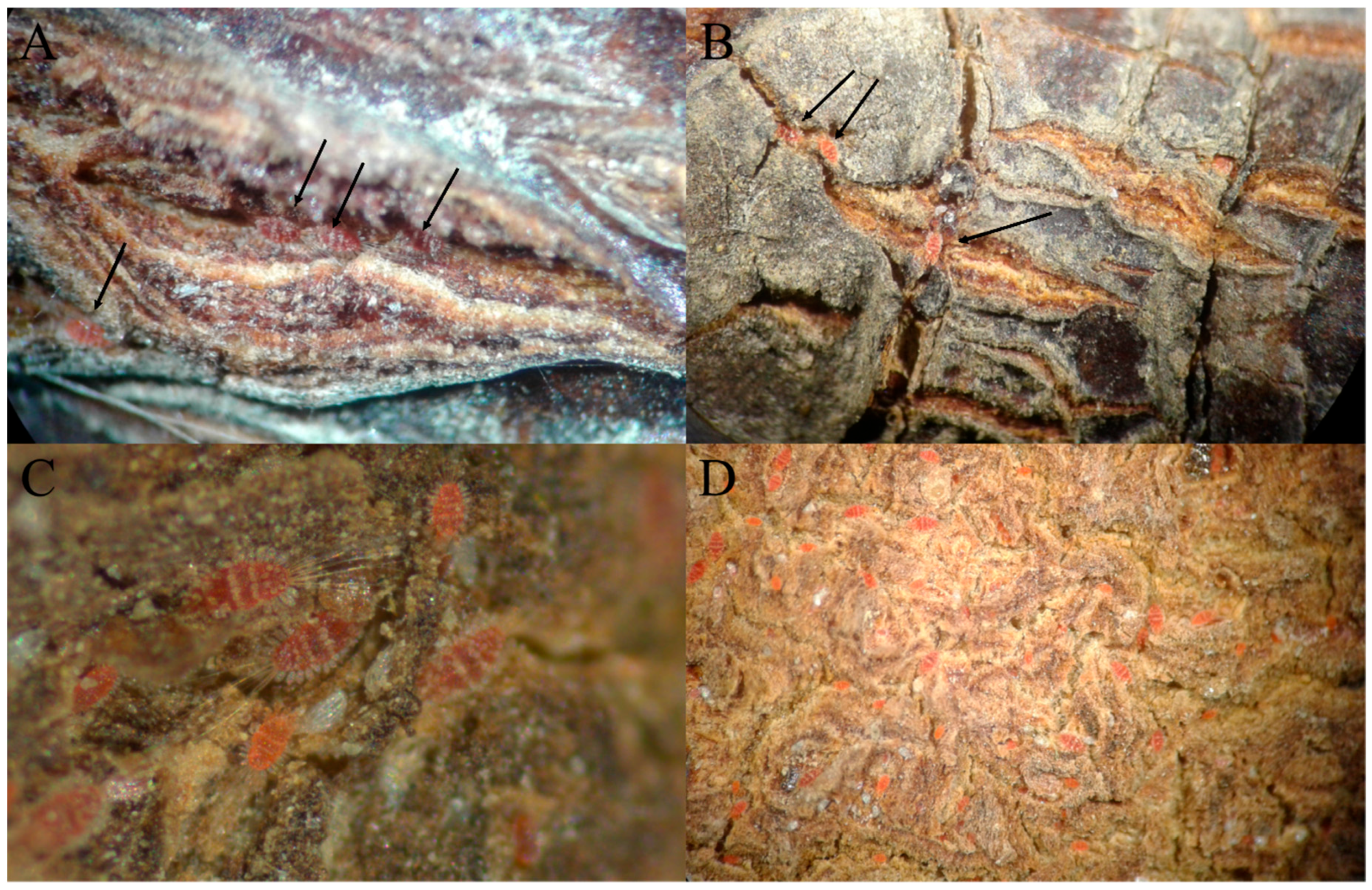
| Localities/Departament | Collection Date | Coordinates | Average Mites/Branchlets | Average Mites/cm2 Fruit Surface | |
|---|---|---|---|---|---|
| South | West | ||||
| Los Ranchos/Piura | 25–Nov.–2020 | 5°16′50.28″ | 79°40′16.44″ | 3.0 | 17.0 |
| Querecotillo/Piura | 03–Dec.–2020 | 4°50′14.31″ | 80°39′22.82″ | 3.5 | 18.5 |
| Morropón/Piura | 03–Dec.–2020 | 5°19′49.82″ | 79°52′44.55″ | 2.0 | 13.5 |
| Tambogrande/Piura | 03–Dec.–2020 | 4°53′49.50″ | 80°27′41.40″ | 3.5 | 15.5 |
| Tambogrande/Piura | 03–Dec.–2020 | 4°52′51.70″ | 80°19′19.40″ | 2.5 | 16.0 |
| Salitral/Piura | 03–Dec.–2020 | 5°32′21.50″ | 79°43′10.70″ | 0.0 | 4.0 |
| Tambogrande/Piura | 04–Dec.–2020 | 4°54′28.00″ | 80°20′45.49″ | 2.0 | 19.0 |
| Huangala/Piura | 04–Dec.–2020 | 4°50′19.36″ | 80°36′18.78″ | 0.0 | 2.5 |
| Ex CP7 Tambogrande/Piura | 04–Dec.–2020 | 4°54′1.20″ | 80°15′29.24″ | 0.0 | 7.0 |
| Tambogrande/Piura | 04–Dec.–2020 | 4°56′14.48″ | 80°15′11.50″ | 0.0 | 5.0 |
| Morropón/Piura | 04–Dec.–2020 | 5°10′23.28″ | 79°57′50.40″ | 2.0 | 6.0 |
| Tambogrande/Piura | 06–Dec.–2020 | 4°53′35.31″ | 80°20′32.85″ | 0.0 | 13.0 |
| San Juan De Bigote/Piura | 06–Dec.–2020 | 5°17′43.08″ | 79°42′11.58″ | 1.5 | 1.0 |
| Salitral/Piura | 06–Dec.–2020 | 5°30′51.40″ | 79°42′33.30″ | 10.5 | 6.0 |
| Tangarara/Piura | 06–Dec.–2020 | 4°54′0.31″ | 80°51′8.84″ | 2.5 | 5.5 |
| Morropón/Piura | 06–Dec.–2020 | 5°11′34.80″ | 79°58′11.22″ | 9.0 | 8.0 |
| San Juan De Bigote/Piura | 06–Dec.–2020 | 5°19′37.68″ | 79°43′33.84″ | 4.0 | 5.0 |
| La Legua/Piura | 06–Dec.–2020 | 5°14′15.9″ | 80°39′48.8″ | 2.0 | 9.0 |
| La Legua/Piura | 06–Dec.–2020 | 5°14′18.2″ | 80°39′47.2″ | 4.0 | 10.5 |
| Salitral/Piura | 07–Dec.–2020 | 5°19′35.10″ | 79°52′44.02″ | 5.0 | 15.0 |
| Tambogrande/Piura | 07–Dec.–2021 | 4°53′20.72″ | 80°26′14.85″ | 0.0 | 9.5 |
| Tambogrande/Piura | 07–Dec.–2022 | 4°52′20.94″ | 80°26′11.73″ | 14.0 | 23.5 |
| Quemazon/Piura | 09–Dec.–2020 | 5°18′8.83″ | 79°42′18.55″ | 7.0 | 17.5 |
| Singucate/Piura | 09–Dec.–2020 | 5°16′44.44″ | 79°40′53.59″ | 4.0 | 16.0 |
| Buenos Aires/Piura | 21–Jan.–2021 | 5°14′35.63″ | 79°57′33.25″ | 8.5 | 10.0 |
| Los Cedros/Tumbes | 11–Oct.–2021 | 3°36′51.22″ | 80°31′53.10″ | 1.5 | 5.5 |
| Cabuyal/Tumbes | 03–Nov.–2021 | 3°43′6.12″ | 80°26′7.74″ | 0.0 | 8.5 |
| Location | Host (Family) | References |
|---|---|---|
| Brazil | Malpighia emarginata D.C. (Malpighiaceae) Litchi chinensis Sonn (Sapindaceae) | [26] [27] |
| Caribbean | Annona muricata L. (Annonaceae) Lantana camara L. (Verbenaceae) Turnera ulmifolia L. (Passifloraceae) | [28] [28] [28] |
| Costa Rica | Psidium cattleianum Sabine (Myrtaceae) Malpighia glabra L. (Malpighiaceae) Persea americana Mill. (Lauraceae) | [6] [29] [30] |
| Cuba | Achras sapote L. (Sapotaceae) Casuarina equisetifolia L. (Casuarinaceae) Persea americana | [31] [31] [32] |
| Peru | Theobroma cacaoL. (Malvaceae) Cydonia oblonga Mill. (Rosaceae) Mammea americana L. (Calophyllaceae) | [25] [33] present study |
| Republica Dominicana | Persea americana | [Ochoa, pers.obs.] |
| USA | Hibiscus spp. (Malvaceae) Carica papaya (Caricaceae) Persea americana Quercus spp. (Fagaceae) | [1,4] [4] [Ochoa, pers.obs.] [34] |
| Biometric Characteristics | Means ± SE | 95% Confidence Interval |
|---|---|---|
| Average fruit weight (g) | 397.23 ± 20.79 | 355.40–439.00 |
| Average pulp weight (g) | 228.28 ± 15.21 | 197.70–258.85 |
| Average seed weight (g) | 87.34 ± 5.36 | 76.57–98.10 |
| Average fruit height (cm) | 9.02 ± 0.13 | 8.74–9.28 |
| Average fruit circumference (cm) | 28.96 ± 0.52 | 27.90–30.00 |
| Average seed number | 1.52 ± 0.11 | 1.30–1.73 |
| Percentage of pulp (%) | 56.51 ± 1.74 | 53.02–60.00 |
| Percentage of seed (%) | 22.29 ± 0.95 | 20.37–24.20 |
| Percentage of epicarp (%) | 21.2 ± 1.03 | 19.12–23.26 |
| Ratio pulp/seed | 2.88 ± 0.17 | 2.52–3.22 |
Publisher’s Note: MDPI stays neutral with regard to jurisdictional claims in published maps and institutional affiliations. |
© 2022 by the authors. Licensee MDPI, Basel, Switzerland. This article is an open access article distributed under the terms and conditions of the Creative Commons Attribution (CC BY) license (https://creativecommons.org/licenses/by/4.0/).
Share and Cite
Escobar-Garcia, H.A.; Beard, J.J.; Ochoa, R. Report of Tuckerella pavoniformis (Acari: Tuckerellidae) on Mamey, Mammea americana (Calophyllaceae), in Northwestern Peru. Insects 2022, 13, 473. https://doi.org/10.3390/insects13050473
Escobar-Garcia HA, Beard JJ, Ochoa R. Report of Tuckerella pavoniformis (Acari: Tuckerellidae) on Mamey, Mammea americana (Calophyllaceae), in Northwestern Peru. Insects. 2022; 13(5):473. https://doi.org/10.3390/insects13050473
Chicago/Turabian StyleEscobar-Garcia, Hector Alonso, Jennifer J. Beard, and Ronald Ochoa. 2022. "Report of Tuckerella pavoniformis (Acari: Tuckerellidae) on Mamey, Mammea americana (Calophyllaceae), in Northwestern Peru" Insects 13, no. 5: 473. https://doi.org/10.3390/insects13050473
APA StyleEscobar-Garcia, H. A., Beard, J. J., & Ochoa, R. (2022). Report of Tuckerella pavoniformis (Acari: Tuckerellidae) on Mamey, Mammea americana (Calophyllaceae), in Northwestern Peru. Insects, 13(5), 473. https://doi.org/10.3390/insects13050473








